FRENCH SILVERPLATE MARKS
PLATED AND ELECTROPLATED SILVER MARKS OF FRANCE
DOUBLÉ, PLAQUÉE, METAL, METAL BLANC, MÉTAL ARGENTÉ |
This is a page of A Small
Collection of Antique Silver and Objects of vertu, a 1000
pages richly illustrated website offering all you need to know
about antique silver, sterling silver, silverplate, sheffield
plate, electroplate silver, silverware, flatware, tea services
and tea complements, marks and hallmarks, silver marking system and silver
hallmarks guide, articles, books,
auction catalogs, famous silversmiths (Tiffany, Gorham, Jensen,
Elkington, WMF, Reed & Barton, Mappin & Webb, Bateman Family),
history, oddities ...
SITE MAP -
HOME PAGE
|
FRENCH SILVERPLATE MARKS
DIRECTORY BY INITIALS/SYMBOLS DIRECTORY BY NAMES
MAKER'S MARK INITIAL: A - B
C - D
E - K
L - O
P - Z
|
|
|
French solid silver is characterized by series of hallmarks and the presence of the maker's mark in a lozenge/diamond-shaped cartouche.
On plated metal a square or rectangular cartouche is used for maker's mark.
From 1797 the mark of the "métal plaqué", equivalent to British "Old Sheffield Plate", was a square or rectangular cartouche containing:
- the initials of the maker
- the word "DOUBLÉ" or "PLAQUÉ"
- the figure indicating the quantity of silver (optional)
The thickness of silver was indicated by a number followed by a small "E", "M" or "EM", as abbreviation of Dixième (Tenth). The number represented the percentage of silver relative to the base metal (higher numbers are indicative of the poorest quality of plating)
|
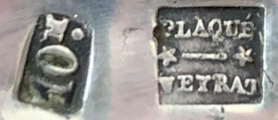
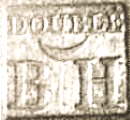
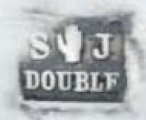
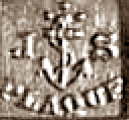
|
From 1860, to differentiate the "métal plaqué" from the "argenture par dépôt électrolytique", equivalent to British EPNS (Electro Plated Nickel Silver), were used square marks containing:
- the initials of the maker and the figure indicating the quantity of silver
|
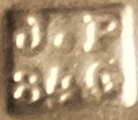
|
- the initials of the maker, a symbol and the figure indicating the quantity of silver
|
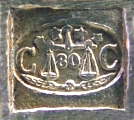
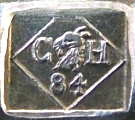
|
- the initials of the maker and a symbol accompanied by another cartouche containing the figure of the silver content
|
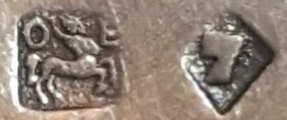
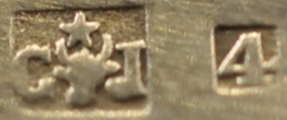
|
Sometimes they are accompanied by additional marks with the inscription "METAL" or "METAL BLANC" (WHITE METAL)
|

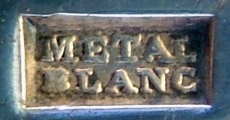
|
|
|
MÉTAL ARGENTÉ
|
To strengthen consumer protection, the French Parliament voted on July 1, 1983 a law which reformed the Guarantee and codified the conditions of silver hallmarking. In this context it was decided to measure the thickness of silver deposited on the entire surface and to institute minimum standard thicknesses for silverplate.
The old mark expressed in grams, which is not compulsory, remains in use. Often it indicates silver weights greater than the new imposed standards.
The new square hallmark (applicable from August 1984) therefore guarantees the thickness of the silver layer deposited on the item.
The POINÇON CARRÉ is the official mark for "métal argenté".
It is a square containing:
- I or II, identifying the first or second quality of manufacture
- a symbol identifying the maker
- the initials of the maker
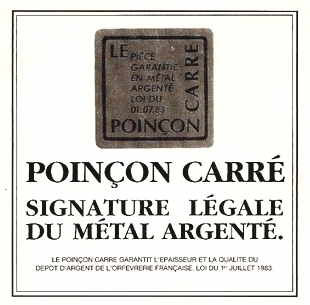
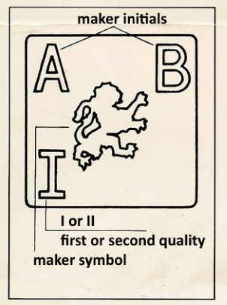
|
These are the requirements to be allowed to use the "POINÇON CARRÉ" mark and "métal argenté" denomination
(plating thickness is measured in Micrometers: a micron is one thousandth of a millimeter or 0.001mm).
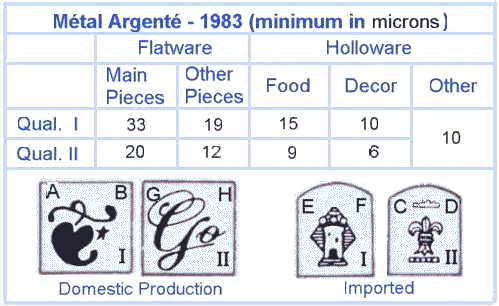
|
|
|
NUMBERS IN FRENCH SILVERPLATE
|
The meaning of numbers in French silverplate marks has changed over time:
1797 - c. 1860
number accompanied by "E", "M" or "EM" (meaning Dixiéme / tenth) in the upper right corner. This number is the percentage of silver used to plate the copper ingot (plating was made using the system known in the UK as "Old Sheffield Plate")
c. 1860 - 1983
number alone or accompanied by "G" or "GR". This is the number of grams of silver used to plate a single item or a dozen of spoons or forks (referred to the process of silver electroplating which has supplanted the OSP system)
after 1983
"Roman" numbers I or II in a corner. This number identifies the first or second quality of "métal argenté". The quality of the plating is determined by the microns of silver present on the item (a micron is one thousandth of a millimeter or 0.001mm).
|
DIRECTORY OF FRENCH SILVERPLATE MAKERS
INITIALS & SYMBOLS
|
AB and a crescent and four stars
AB and a bumblebee
AC and a crowned cross of honor
AC and a lyre
AD and a woodcock
AD and a lion
AD and and a hammer and a wooden peg
AF and an anchor
AF and a half moon
AG and a bag
AG and a symbol
AL and a symbol
AL and an anchor
AL and two crossed cutlery
AL and a crescent, a star in the middle
ALFENIDE and a goat
A.LOISEAU and a crowned cross of honor
ALPACCA and a mouse
AM and a mallet
AP and a horse's head
APOLLONOX
AR and a wheel
ARDJ and a cross
ARGENTA into a shield and a lion
ARGIT
AS and a ram's head
AU BON MARCHÉ
BAILLIER
B.B
BB
BB and a crown
B Cie and a bicycle wheel
BJ and a crayfish
B.P into a shield, under a star
C&L and a comet
C&L and two stars
CB and a grasshopper
CB and a press
CB and a symbol
CB and a sun
CC and a scale
CD and a dog's head
CD and a hare's head
CG and a tree
CH and a goat
CH and a sun
CJ and an ox's head
CL and a child's head
CL and an egg cup
CL and cup
CM and a handshake
CM and a blackberry with two leaves
CM and two crossed pipes and two stars
C.O.P. and two stars
C.O.P.
CP and a press
CROIX DE LORRAINE (CROSS OF LORRAINE) figural mark
CS and a five leaf clover
CV and an ant
CY and a symbol
DAM and a tree
DC and a bear
DC and a turtle
DD interwined
DEBAIN and a phoenix and a star
DF or DFES and a rooster's head
DG and a hand
DIXI and a dice
DL and a candlestick with the burning candle
DH and METAL BLANC
DM and a cup
DR and a press
EB and an hourglass
EC Vve and a running rabbit
EC L and a wreath
EH and a stirrup
EP and a pocket knife
E PROST and a fork
E.V. METAL
FC and a crown
FELIX Fres
FF and a croissant
FF and a winged lion
FF sorrounding a mallet
FL and a crescent moon, an arrow, a star below
F.N and a six pointed star in a sun
FO and map of France
FONTALIRANT and a crescent under a star
G (Gothic) into a crowned shield
GANDAIS and DOUBLÉ into a square
GB and a stool
GB and a dog into a square
GC and a hammer
GC and a sword
GC and a cross of Lorraine
G.D. and a wolf dog head
GD and a silversmith's hammer
GD and a press
GD and a cup flanked by two dolphins
GD and a star
GFL and a chisel
GFres and crossed hammer and brush over a star
GG and a boxer
GG and a star
GM
G.R. and an eagle
GR and a winged helmet
GR and an engraver tool with a star
GR and a cup flanked by two dolphins
GV and a van
GW and the word FRANCIA
H&Cie and a rosebud above, a star below the initials
H.B and a bird
H.Fres and a flower
HL and an olive branch
HL and a windmill
HK and a grasshopper pierced by an arrow
HS and a rising sun
IM AM and a mallet
J & Cie and a bird (jay)
JA and an arrow
JACQUIN and two opposite heads
JB and a star over a lyre
JDT and a tower
JH and a bell
JM and a gabion
JP
J.P and a ram
JR and a sitting squirrel
K&Cie under a +, over a star
L and a seated lion
L&L and a crown
L&S and an anchor
LA and a symbol
LC and two crossed cutlery
LCF under a crown, into an araldic shield
LEMAITRE & RIDOUX
LF and a two interlaced L
LL and a crown over a star
LL under a crown
L&L under a crown
LL Vve and two crossed oars
LM and a three leaf clover with two stars
LMP into an oval
LP and a horse's head
LR and crossed spoon and forks over a star
LR and two palms, three stars above, four stars below
LR and a wing, a palm, three stars above, four stars below
LS and a hunting horn
LUTETIA
LV intertwined
LUX and two terrestrial globes and an anchor
MANUFre FRANCse NICKEL PUR and a boar
MB and a symbol
MB and a dear head
MB and radiant sun forming the O and capped by a moon
M BARRÉ and a shamrock
MC and a star and bee into a star
MD and an anvil
M.F.B.O. into a sun
M GOUAILLE and a star
MINERVA and head of Minerva into a shield
ML and a daisy
MM and an ear
MPR and a sword, two anchors and sacred heart
N&A and a crank
N&C and a bee
NB and a windmill
NC and a cock and three stars
O and an oil lamp
OB and a five-pointed star in a triangle
OC and a rising sun over a star
OC and a chess horse
OE and a centaur
OE and LUTETIA into a crowned shield
OL and statue of liberty or a symbol
OP and a pot and a horseshoe
ORFÈVRERIE GALLIA and a rooster within a shield
OP a pot and a horseshoe
ORVAL inside a square
P.& B.H and P.& B.L into an oval
PA and the head of an Egyptian pharaoh
PAX LABOR
PB (or Sté PB) and a cross (or a dagger)
PB and a hammer
PB and a hammer
PD and a spoon
PE MA J around a star
PG and a helmet
PG and a rake
PHENIX
PM and a symbol
PM and a windmill
P MASSAT and a lyre with a point on each side
PP and a lozenge
PS and a symbol
PT and a bird's nest
R&Cie and a clover
R&D and a clover
RD and a clover
REX
RK and a winged elephant
RM and a star
RM and a lamp
RR and a cross
RVP inside three shields into a circle
SA and a halberd
SF and four stars or above R
S.F.A.M. and a handshake
SFOA and a bee or a stylized teapot
SM crest with bishop's crozier
SM and a palm
SMF and fleur de lys
SNO around a crown
SO over G and a crown
SOH
SP and a caduceus
Sté S and a cross into a shield
TA and a lion
TA ET FILS a standing lion holding an oval
TD intertwined
T.Fres and a terra cotta casserole dish
TL a ewer from Dinant
UDNER
VDM and two crossed cutlery and a star
VER DEL into a square
VER DEL into a square
VEYRAT and two stars
VH and a seated lion
VL and a sailing ship
VS and a three-masted boat
VveD and a woman's head with helmet
WISKEMANN
THREE-MASTED BOAT figural mark
DIRECTORY OF FRENCH SILVERPLATE MAKERS
NAMES
Alexandre & Bourdon
Alfenide
Allard Philippe Joseph
Apollonox Coutellerie de table
Argental Société Anonyme
Asésio Th.
Asesio Thomas et fils
Au Bon Marché
Auzolle Léopold
Babarit Henri
Balaine C.
Barra (Maison)
Barré Marcel
Benoit Georges
Bietrix Marc
Bognon Pierre
Boin - Taburet
Bouillet & Bourdelle
Boulenger Adolphe
Bourgeois Nicolas
Boyer Paul
Boyron Claudius Louis
Brille Henri Emile
Brille J.
Brosse & Cie
Brossier Léon
Cailar & Bayard
Cailar & Henry
Capello-Morel
Caploun André
Capmartin Dominique
Cardeilhac Amélie
Carpentier Gustave fils
Cavy
Charpentier
E. Chauvin & Lacombe
E. Chauvin & Lacombe
Chéron Félix
Chevalier Gustave
Christofle
Collet Noël
Collignon & Léger
Compagnie de l'Orfèvrerie Parisienne
Compère Léontine Veuve
Comptoir Paris Province
Coutellerie de table Apollonox
Crégut Daniel
Crossard Joseph
Dahl Aksel
Debain Alphonse
Debain Alphonse & Edouard
Delaire Veuve
Della Torre Joseph
Delpech Gaston
Derivry Auguste
Deschamps Frères
Devouge Pierre
Devouge & Dupont
DIXI Société des Couverts
Dreville & Labie
Dufour Gaston
Duguine Clément
Duriez Charles
Durousseau G.
Durousseau & Raynaud
Ercuis (Orfèvrerie)
Félix Frères
Fontalirant A.
Fouquet-Lapar George
Frenais Armand / A. Frionnet & Cie
Frionnet Albert
Frionnet François
Gallia
Gandais Jacques Augustin
Gay Gabriel & Cie
Gelb A.
Gérard Denis
Giacobbi Georges
Gigon Paul
Gombault
Gombault & F. Chéron
Gonthier Jeune & Cie
Gouaille Maurice
Grands Magasins du Louvre
Gudin Adolphe
Guillaumot Paul-François
Halphen Charles
Haskelson Jean
Hauser Frères
Hénin & Cie
Henry Théodore
Hermès Emile
Jacquin Alf.
Jaymes & Cie
Julien Charles
Julien Pierre
Kahn & Compagnie
Kindberg Henry
Lager E.P. Manufacture d'Orfèvrerie Metal-Blanc
Lambert Léonie
Lamy & Lacroix
Landenwetsch Henri
Laurent Charles
Le Couvert Francais
Leclerc Aristide
Legrand Homère
Legros Marius
Lejeune A.
Lemaitre & Ridoux
Lenain & Fils
Lenfant César
Lesage Marc
Levrat François
Lévy, Martin & Plainchault
Loiseau A. & Cie
Longuet Camille
Lorraine Orfèvrerie
Lutetia
Lutetia
Mailhan
Mailhan & Mailhan
Maison Barra
Maison Bautz
Manufacture française de Nickel Massif Pur
Manufacture Française d'Orfèvrerie Maison Bautz
Marson Robert
Massat Frères
Mégemond Joseph & Charles Deneux
Meurgey Pierre
Mestrallet Sylvain
Morel Paul
Moucheront Jean
Murat Charles / Maison Murat S.A
Nadal
Nicolle Fred.
Nivard & Couillard
Noury Jules & Allain Edmond
Odiot (Maison)
Olier & Caron
Orfèvrerie Christofle
Orfèvrerie de Chambly
Orfèvrerie Ercuis
Orfèvrerie Gallia
Orfèvrerie MG Montibert
Orfèvrerie Liberty
Orfèvrerie Lorraine
Orfèvrerie Phénix
Orfèvrerie Pot fer
Orfèvrerie Rex
Orfévrerie St. Médard
Pernot & Semin
Perrin Claude Orfèvrerie
Phénix (Orfèvrerie)
Philippe Alfred
Philippe Louis
Picard & Bazin-Levallois
Pichard-Balme
Pillet C.
Pottecher & Cie
Poussielgue Rusand Maurice
Prost Ernest
Prud'homme Stéphane
Puiforcat Emile
Ravinet & Cie
Ravinet Louis
Ravinet Louis & Denfert Charles
RENEKA
Rex Orfèvrerie
Reysec Rodolphe
Reysec & Varenne
Roberge André
Robert Louis
Rocher Georges
Rocher Jules
Roux - Marquiand
Rouyer
S.F.A.M.
Saglier Frères
Saglier Victor
Schooman Louis
Sicre Charles
Société Anonyme Argental
Societé Décoration Moderne
Societé d'Orfèvrerie Hotelière
Société des Couverts de Mouroux
Société des Couverts DIXI
Société Française d'Alliage de Métaux
Société Francaise d'Orfèvrerie d'Art
Société Française du Métal Minerva Clair & Cie
Sté France Orfèvrerie
Soufflot Henri
Soulat Auguste
St Hilaire
St. Médard (Orfévrerie)
Sté Savoie
Tétard Frères
Tête & Leroy
Thèze, Deance & Cie (Crysor)
Tosany Paul
Udner
Van den Bogaert Guillaume
Varet E.
Vernot, Délean & Cie
Veuve Léontine Compère
Veyrat Jean-François
Vuitton Louis
Well George
Wiskemann
DIRECTORY OF FRENCH SILVERPLATE MAKERS
NOT IDENTIFIED
Maker not identified AC
Maker not identified AL
Maker not identified BAILLIER
Maker not identified CG
Maker not identified CV
Maker not identified CY
Maker not identified DAM
Maker not identified DH
Maker not identified FF
Maker not identified FF
Maker not identified GD
Maker not identified G.R.
Maker not identified GR
Maker not identified JP
Maker not identified L&S
Maker not identified LC
Maker not identified LR
Maker not identified MM
Maker not identified OG
Maker not identified ORVAL
Maker not identified PAX LABOR
Maker not identified PE MA J
Maker not identified SMF
Maker not identified VDM
Maker not identified VL
|
FRENCH SILVERPLATE MARKS
DIRECTORY BY INITIALS/SYMBOLS DIRECTORY BY NAMES
MAKER'S MARK INITIAL: A - B
C - D
E - K
L - O
P - Z
|
|
|
This is a page of A Small Collection of Antique Silver and Objects of vertu, a 1500 pages richly illustrated website offering all you need to know about antique silver, sterling silver, silverplate, sheffield plate, electroplate silver, silverware, flatware, tea services and tea complements, marks and hallmarks, articles, books, auction catalogs, famous silversmiths (Tiffany, Gorham, Jensen, Elkington, WMF, Reed & Barton, Mappin & Webb, Bateman Family), history, oddities ...
SITE MAP
SILVER DICTIONARY
|

www.silvercollection.it
This page was useful? leave your LIKE on
facebook
|
work in progress on this page - your help, corrections and suggestions will be greatly appreciated -
|
|